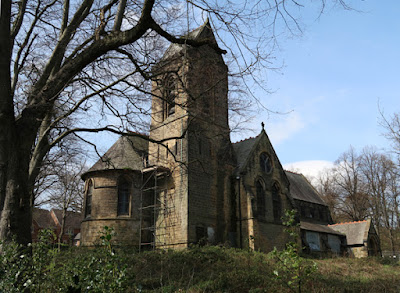 |
| A tree stump at Wadsley Fossil Forest (2003) |
Leaving The Quarry, I continued up Middlewood Road until I reached the former porter’s lodge (1877) of the South Yorkshire Asylum, which was probably designed by Bernard Hartley – the West Riding of Yorkshire surveyor who was responsible for the Middlewood Hospital (1871).
I just took a few photos of this Grade II Listed building for the British Listed Buildings website and then continued into the new estate until I reached the Middlewood Hospital church (1875), which was also probably designed by Hartley - according to the Historic England description.
The church has been disused for more than 25 years, with various plans to convert it into apartments being unsuccessfully submitted to Sheffield City Council. At the time of my visit, the windows were boarded up and it could only be seen from a distance through heras fencing.
The stonework was moderately dirty and I couldn’t get much of an idea about its physical characteristics; however, looking at my photographs, the massive sandstone used here has grey to orange/brown colouration that is consistent with the Loxley Edge Rock, which was extensively quarried at Wadsley Common and on the lower slopes to the east of Worrall.
I then went to have a look at Middlewood Lodge, a gated development of 38 apartments that has been converted from the original administration block. From a distance, the sandstone used for dressings looks uniform in colour and, as seen at the lodge, is probably Derbyshire gritstone.
The next stop on my walk was the replica fossil tree stump, installed with an interpretation panel in 2018, which marks the site of Wadsley Fossil Forest. This was cast from a mould of one of several stumps that were discovered in 1872, when land was being levelled before the hospital was built.
As the Chairman of the barely functioning South Yorkshire RIGS (Regionally Important Geological Sites) Group, I had seen one of the original stumps back in 2003, when members of the Sorby Natural History Society, who had volunteered to do the clearance, were invited to attend a talk by Duncan McLean - then at Sheffield University - before they were buried.
When originally uncovered, the eminent Sheffield geologist, Henry Clifton Sorby, was informed of the discovery and it was largely down to his efforts that the importance of these was recognised. Although very many Carboniferous tree stumps have been found in the UK - including the one seen at Sheffield Botanical Gardens - it is very rare to encounter several stumps in one place and Henry Sorby arranged for sheds to be built, to provide shelter and to allow visitors to see them.
Continuing my walk, I then photographed the Grade II Listed former Kingsway Ward (1878), which is now the Kingsway Hall apartments. It is again brick built with massive sandstone dressings but, looking at the latter from a distance, it does not appear to use the same stone that can be seen in the lodge and the administration block.
Moving closer to get a better look at the arch to the main entrance and other high level details, the sandstone is distinctly yellow in colour, which is typical of the Grenoside Sandstone seen at Grenoside and Birley Carr and not Derbyshire gritstone.
Making my way down towards Middlewood Road by the public footpath, I stopped briefly to look at the view of the escarpment of the Greenmoor Rock, which forms Birley Edge and continues south through Sheffield - where it is seen in several prominent landforms.
 |
| A panoramic view of Birley Edge |
Arriving at Middlewood Road, I took a few quick snaps of the very coarse grained sandstone used for the boundary walls and the terraced houses, where the grey to orange/brown colouration seen beneath the dirt suggests that this is another example of locally quarried Loxley Edge Rock.











No comments:
Post a Comment